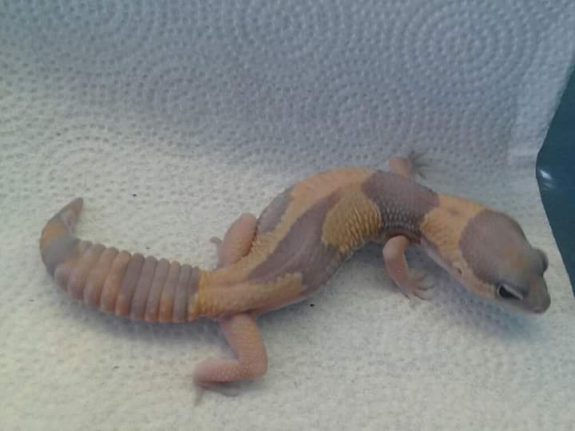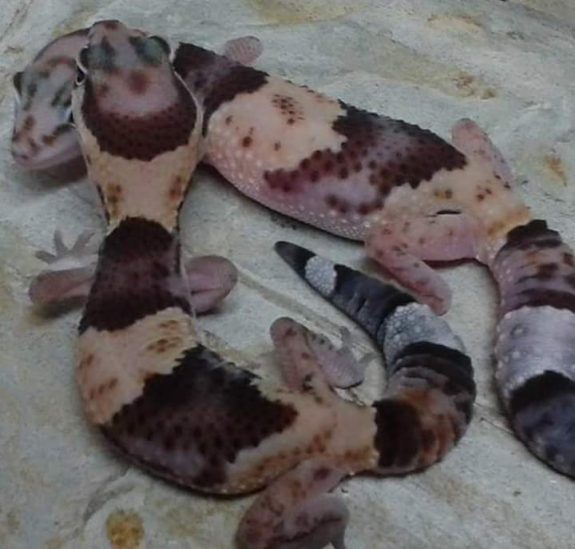| For many years it seemed as if African Fat Tail geckos (Hemitheconyx caudicinctus) were simply drab cousins of the much more popular leopard geckos. With the advent of new morphs such as whiteout, zulu and oreo, the fat tail palette colors and patterns has exploded and their popularity has soared. Despite this, it was very difficult to find people willing and able to answer some of Gecko Time’s questions about them.
You can learn more about African Fat Tail geckos by reading Gecko Time’s other two AFT centered articles, one about morphs and one about the species in general. It seems as if there is a decrease in the banded look of certain AFT’s such as the white-out. Do you find that the case and if so, to what do you attribute it? Jessica Smith: I don’t think there is a deliberate effort to move away from the banded look of fat tails. I think breeders are just expanding the hobby with different morphs such as Zulus, Patternless and of course White Out combination morphs. The White Out morph has completely changed the fait tail industry. Normal banded and striped fat tails have been around a long time and I think people are just excited with the new patterns and colors now available. Nick Puppo: Even though my favorite pattern morph is a Zero which has the white dorsal stripe, I actually prefer the banded morph in my opinion the dorsal stripe takes away from the contrast between the lighter and sometimes more colorful bands and the dark bands.  How do you compare your AFT hatch rate with that of other gecko species you breed? If it’s lower, to what do you attribute it? Jessica: My hatch rate with fat tails is very high. I don’t think they are as prolific as some species of geckos, but I do not consider that a bad thing for the market. I attribute my hatch rate success to a variety of factors including the way I incubate and care for and raise my breeders. My process is slightly different than most breeders and I have been very happy with the results. Nick: Well African fat tail gecko eggs in my experience tend to be more delicate than leopard gecko eggs but not as difficult as some of the other species I’ve worked with. The eggs tend to have a stricter requirement for specific humidity, which has to be just right. I tend to open my egg boxes every now and again during incubation to make sure they aren’t too wet or too dry. As prices decrease for many of the new AFT morphs, what do you feel will be happening with the AFT market in the next few years? Jessica: I think the market for fat tails has been and will continue to be very strong for many years. Price drops are inevitable as more breeders have success producing both common and rare morphs. My focus has always been to produce the best looking fat tails possible and they are my number one passion in reptiles. I have literally been selling them worldwide and the demand for them overseas is as strong or stronger than here in the USA. As prices drop on some morphs, others remain steady due to demand exceeding availability. At a lower price point more hobbyists are able to enjoy these amazing geckos and I see no indication of that slowing down anytime soon. Nick: Fattails tend to hold their value a little better than leopard geckos due to them not being as prolific but the prices on the newer morphs will drop and make them more affordable to other hobbyists that will help in the development of newer morphs and combinations. 
Gecko Time RespondsI am pleased to hear from experienced fat tail gecko breeders and am intrigued by the hints that there may be some things that can be done to improve hatch rate which has not been great for me. I encourage the contributors as well as anyone else to add their experiences and opinions in the comments section. Inspired as a little boy by his Grandfather’s fish tanks, Nick Puppo found himself intrigued with tropical fish. At a young age he got his first job in a pet store. It is here where his passion for fish grew, as well as, his new found fascination for reptiles. What was so intriguing was their diversity. So many colors, species, and habitats. A new passion arose. It was in Southern California that he got a great opportunity to work for Bob Mailoux at the Sandfire Dragon Ranch. This was a chance to work with some of the best. True pioneers of the reptile world. It was here that he worked on the original Hypo Bearded Dragon Project. Working for many years as an East Coast Representative, the next step was to try this for himself. Over fifteen years ago he started “Lecko My Gecko” specializing in high colored leopard geckos, fat tail geckos, and crested geckos. Currently, he is co-owner in F.N. Geckos working with fat tail, leopard, and gargoyle geckos. He has also started to breed a variety of chameleons and frogs. Jessica Smith is the co-owner of Gecko Babies along with her fiancé Brandon. Together they have been keeping and breeding reptiles since 2003. Jessica’s reptile collection started with Bearded Dragons and a Leopard Gecko. Since then her collection has grown to over 200 animals and currently includes many different species including African Fat Tail Geckos, Leopard Geckos, Ball Pythons, Green Tree Pythons and Western Hognose. In addition to keeping reptiles, Jessica is an avid Saltwater Aquarium enthusiast with experience in well over a dozen different species tanks including Coral Reefs and Captive Coral Propagation, Fish Only Systems, Seahorses, Eels and Sharks. Her website is www.geckobabies.com |

